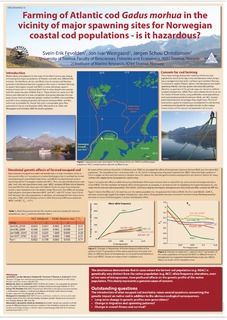| dc.contributor.author | Fevolden, Svein-Erik | |
| dc.contributor.author | Westgaard, Jon-Ivar | |
| dc.contributor.author | Christiansen, Jørgen Schou | |
| dc.date.accessioned | 2012-02-07T08:16:03Z | |
| dc.date.available | 2012-02-07T08:16:03Z | |
| dc.date.issued | 2009 | |
| dc.identifier.citation | This report is not to be quoted without prior consultation with the General Secretary. | no_NO |
| dc.identifier.uri | http://hdl.handle.net/11250/102994 | |
| dc.description.abstract | Waters along and adjacent to the coast of northern Norway are unique
in housing two major populations of Atlantic cod with very di erent life
histories. The Northeast Arctic cod (NEAC) has its nursery and feeding
grounds in the Barents Sea but migrates to the coast of northern Norway
to spawn. Norwegian coastal cod (NCC) is more stationary, spawns
mainly at local sites in individual ords but to some degree also overlap
with the spawning sites of NEAC (Fig.1). These distinctive patterns in life
history are re ected in a clear-cut genetic divergence between the two
populations. Various molecular genetic markers (scnDNA, microsatellites
and SNPs) have displayed genetic di erences between NEAC and NCC
which are remarkable for marine sh with a comparable gene ow
potential (cf. Sarvas and Fevolden 2005, Wennevik et al. 2008, and
Westgaard and Fevolden 2008 for recent updates). | no_NO |
| dc.language.iso | eng | no_NO |
| dc.publisher | ICES | no_NO |
| dc.relation.ispartofseries | ICES CM documents;2009/Q:18 | |
| dc.subject | atlantic cod | no_NO |
| dc.subject | atlantisk torsk (skrei) | no_NO |
| dc.subject | fish farming | no_NO |
| dc.subject | fiskeoppdrett | no_NO |
| dc.title | Farming of Atlantic cod Gadus morhua in the vicinity of major spawning sites for Norwegian coastal cod populations - is it hazardous? | no_NO |
| dc.type | Working paper | no_NO |
| dc.subject.nsi | VDP::Agriculture and fishery disciplines: 900::Fisheries science: 920::Resource biology: 921 | no_NO |
| dc.source.pagenumber | 1 s. | no_NO |
